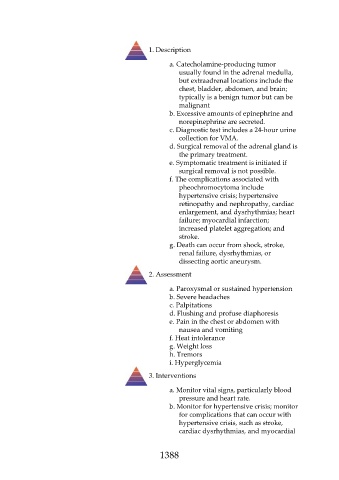Page 1388 - Saunders Comprehensive Review For NCLEX-RN
P. 1388
1. Description
a. Catecholamine-producing tumor
usually found in the adrenal medulla,
but extraadrenal locations include the
chest, bladder, abdomen, and brain;
typically is a benign tumor but can be
malignant
b. Excessive amounts of epinephrine and
norepinephrine are secreted.
c. Diagnostic test includes a 24-hour urine
collection for VMA.
d. Surgical removal of the adrenal gland is
the primary treatment.
e. Symptomatic treatment is initiated if
surgical removal is not possible.
f. The complications associated with
pheochromocytoma include
hypertensive crisis; hypertensive
retinopathy and nephropathy, cardiac
enlargement, and dysrhythmias; heart
failure; myocardial infarction;
increased platelet aggregation; and
stroke.
g. Death can occur from shock, stroke,
renal failure, dysrhythmias, or
dissecting aortic aneurysm.
2. Assessment
a. Paroxysmal or sustained hypertension
b. Severe headaches
c. Palpitations
d. Flushing and profuse diaphoresis
e. Pain in the chest or abdomen with
nausea and vomiting
f. Heat intolerance
g. Weight loss
h. Tremors
i. Hyperglycemia
3. Interventions
a. Monitor vital signs, particularly blood
pressure and heart rate.
b. Monitor for hypertensive crisis; monitor
for complications that can occur with
hypertensive crisis, such as stroke,
cardiac dysrhythmias, and myocardial
1388

